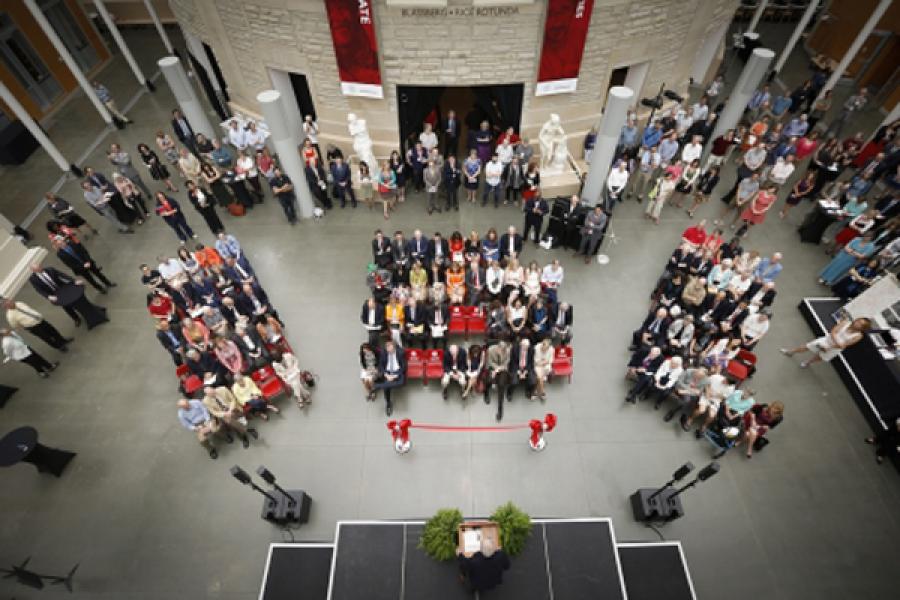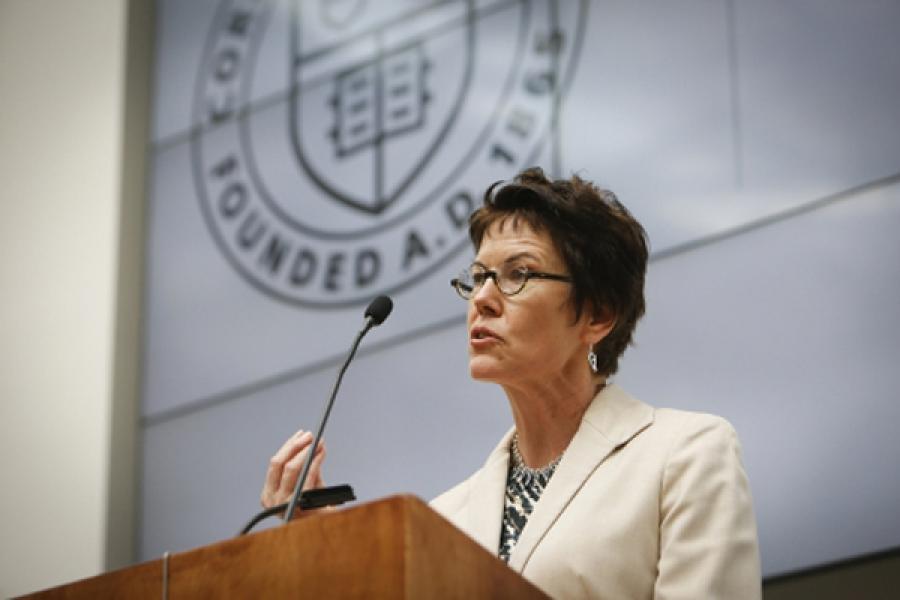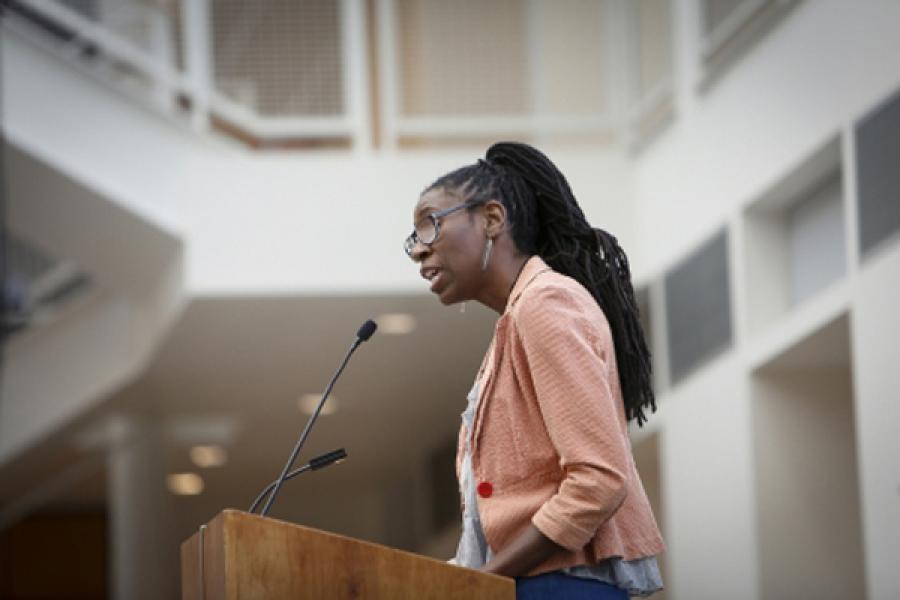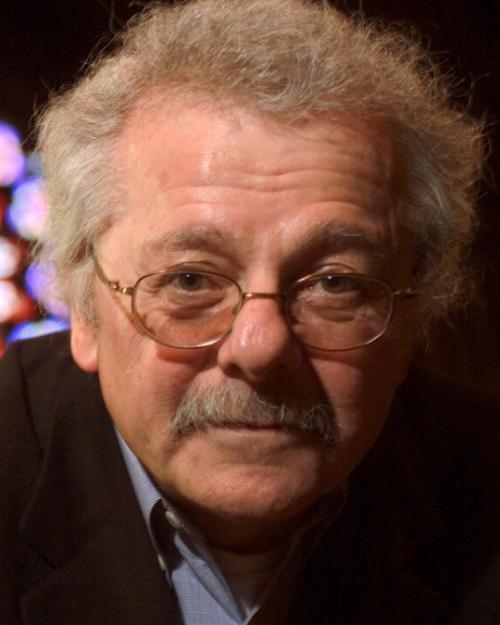Cornell dedicated Klarman Hall May 26 with a celebration featuring poetry, music, a time capsule reflecting life in 2016, and an open house, along with academic panels on the U.S. Constitution and the transformative nature of the humanities.
“This building is an authentic expression of our dedication to the importance of the arts and humanities – in research, creative works and education,” said Gretchen Ritter ’83, the Harold Tanner Dean of Arts and Sciences. “The building’s architects [Koetter Kim & Associates] envisioned this atrium, the Groos Family Atrium, as the center point for the building and imagined it as an Italian piazza – a place of community, gathering and intersection.”
Attached to Goldwin Smith Hall, which was built in 1905, the new building houses faculty offices and seminar rooms for the departments of Romance studies and comparative literature, college academic advising and admissions offices, an auditorium and a café.
“Ever since Andrew Dickson White, in his 1866 Plan of Organization for Cornell, emphasized ‘the absolute and essential importance of human development in its richest diversity,’ the arts and humanities have had a central place at Cornell,” said Hunter R. Rawlings III, interim president. “With the opening of Klarman Hall, for the first time in a century, Cornell has a new general humanities building worthy of our commitment to these essential disciplines.”
Ground was broken for Klarman Hall in 2013, and it opened at the start of this semester in January. True to its designers’ intentions, it quickly became a popular gathering point and hub for the entire campus community.
Ritter, whose office overlooks the atrium, said: “Looking out of my window, I am taken by the hum of activity in this building. On any given day, I see colleagues … engaged in deep conversation; students sitting in circles on the floor and on benches, debating the finer points of their last class; friends, meeting in line at the café.
“The space itself is a perfect expression of our commitment to the humanities. It says that understanding what it is to be human – to aspire, reflect, remember, critique and connect – is at the heart of our presence in the world,” she said, then introduced a video, “A Day in the Life of Klarman Hall.”
Associate professor of English Lyrae Van Clief-Stefanon told the crowd gathered for the dedication of her interest in science and discovery before reading “Building,” her poem commissioned for the event.
A display of the time capsule and its contents included campus event flyers and programs; students’ music mixes; a list of current majors and departments in the college; photographs of the building’s construction; short stories by creative writing students; late President Elizabeth Garrett’s 2015 inauguration program; and booklets filled with recommendations of music, books, art, movies and television from Cornellians of today to Cornell students in 2066.
In their remarks, Rawlings and Ritter acknowledged, among others, former Arts and Sciences Dean Peter LePage and President Emeritus David Skorton for their commitment to the project and to the humanities. The building’s $61 million cost was funded entirely by philanthropy, and they thanked principal supporters Seth ’79 and Beth Klarman, as well as major donors in attendance, who participated in a ribbon-cutting – including members of the Groos family, Richard T. Groos ’52, Thomas T. Groos ’78 and Catherine Groos Augenstein ’86; Judith Lund Biggs ’57 and Suzanne Weiss, who named the auditorium in honor of Presidents Rawlings and Frank H.T. Rhodes; Franci Blassberg ’75, J.D. ’77; Joseph Rice; Bart ’61 and Susan Winokur ’61; Linda and William Macaulay; and Sheila Mossman ’79.
“I am deeply indebted to Cornell for the great education I received here, the maturation that took place while I was here, and the curiosity it has nurtured and nourished, and which has never stopped,” Seth Klarman said. “I learned, but more importantly, I learned how to learn.”
Beth Klarman termed her family foundation’s collaboration and communication with Cornell “a true partnership” from when fundraising began in 2008 and throughout the building’s construction.
“Supporting this project aligns perfectly with our family’s core values,” she said. “We believe we have an obligation to give back, and to turn our own experiences and challenges into opportunities to assist others who walk the same road. … How appropriate to associate our name with a building that is dedicated to the study of how people process and document the human experience.”
This story first appeared in the Cornell Chronicle.








